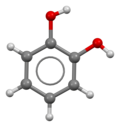Catechol
Catechol (also known as 1,2-dihydroxybenzene or pyrocatechol) is an organic compound with the molecular formula C6H4(OH)2. It is a type of benzene derivative and is one of the three isomeric benzenediols, the others being resorcinol (1,3-dihydroxybenzene) and hydroquinone (1,4-dihydroxybenzene).
Structure and Properties[edit]
Catechol consists of a benzene ring with two adjacent hydroxyl groups. It is a colorless compound that is soluble in water and exhibits a characteristic phenolic odor. The presence of the hydroxyl groups makes catechol a relatively reactive compound, capable of undergoing various chemical reactions such as oxidation and electrophilic substitution.
Synthesis[edit]
Catechol can be synthesized through several methods, including the hydroxylation of phenol using hydrogen peroxide in the presence of a catalyst. Another common method involves the hydrolysis of o-dichlorobenzene.
Applications[edit]
Catechol is used in a variety of industrial and research applications. It serves as a precursor to various chemicals, including pesticides, pharmaceuticals, and flavoring agents. In the field of biochemistry, catechol is used as a substrate in enzyme assays to study the activity of catechol oxidase and other related enzymes.
Biological Role[edit]
In nature, catechol is found in various plants and is involved in the biosynthesis of lignin, a complex polymer that provides structural support to plant cell walls. It also plays a role in the defense mechanisms of plants against herbivores and pathogens.
Safety and Handling[edit]
Catechol is classified as a hazardous substance and should be handled with care. It can cause skin and eye irritation and may be harmful if ingested or inhaled. Proper safety measures, including the use of personal protective equipment, should be followed when handling catechol.
Related Compounds[edit]
See Also[edit]
References[edit]
<references group="" responsive="1"></references>
Catechol gallery[edit]
-
Brenzcatechin
-
Catechol from crystal orientation 2 3D
Ad. Transform your life with W8MD's Budget GLP-1 injections from $75


W8MD offers a medical weight loss program to lose weight in Philadelphia. Our physician-supervised medical weight loss provides:
- Weight loss injections in NYC (generic and brand names):
- Zepbound / Mounjaro, Wegovy / Ozempic, Saxenda
- Most insurances accepted or discounted self-pay rates. We will obtain insurance prior authorizations if needed.
- Generic GLP1 weight loss injections from $75 for the starting dose.
- Also offer prescription weight loss medications including Phentermine, Qsymia, Diethylpropion, Contrave etc.
NYC weight loss doctor appointmentsNYC weight loss doctor appointments
Start your NYC weight loss journey today at our NYC medical weight loss and Philadelphia medical weight loss clinics.
- Call 718-946-5500 to lose weight in NYC or for medical weight loss in Philadelphia 215-676-2334.
- Tags:NYC medical weight loss, Philadelphia lose weight Zepbound NYC, Budget GLP1 weight loss injections, Wegovy Philadelphia, Wegovy NYC, Philadelphia medical weight loss, Brookly weight loss and Wegovy NYC
|
WikiMD's Wellness Encyclopedia |
| Let Food Be Thy Medicine Medicine Thy Food - Hippocrates |
Medical Disclaimer: WikiMD is not a substitute for professional medical advice. The information on WikiMD is provided as an information resource only, may be incorrect, outdated or misleading, and is not to be used or relied on for any diagnostic or treatment purposes. Please consult your health care provider before making any healthcare decisions or for guidance about a specific medical condition. WikiMD expressly disclaims responsibility, and shall have no liability, for any damages, loss, injury, or liability whatsoever suffered as a result of your reliance on the information contained in this site. By visiting this site you agree to the foregoing terms and conditions, which may from time to time be changed or supplemented by WikiMD. If you do not agree to the foregoing terms and conditions, you should not enter or use this site. See full disclaimer.
Credits:Most images are courtesy of Wikimedia commons, and templates, categories Wikipedia, licensed under CC BY SA or similar.
Translate this page: - East Asian
中文,
日本,
한국어,
South Asian
हिन्दी,
தமிழ்,
తెలుగు,
Urdu,
ಕನ್ನಡ,
Southeast Asian
Indonesian,
Vietnamese,
Thai,
မြန်မာဘာသာ,
বাংলা
European
español,
Deutsch,
français,
Greek,
português do Brasil,
polski,
română,
русский,
Nederlands,
norsk,
svenska,
suomi,
Italian
Middle Eastern & African
عربى,
Turkish,
Persian,
Hebrew,
Afrikaans,
isiZulu,
Kiswahili,
Other
Bulgarian,
Hungarian,
Czech,
Swedish,
മലയാളം,
मराठी,
ਪੰਜਾਬੀ,
ગુજરાતી,
Portuguese,
Ukrainian


